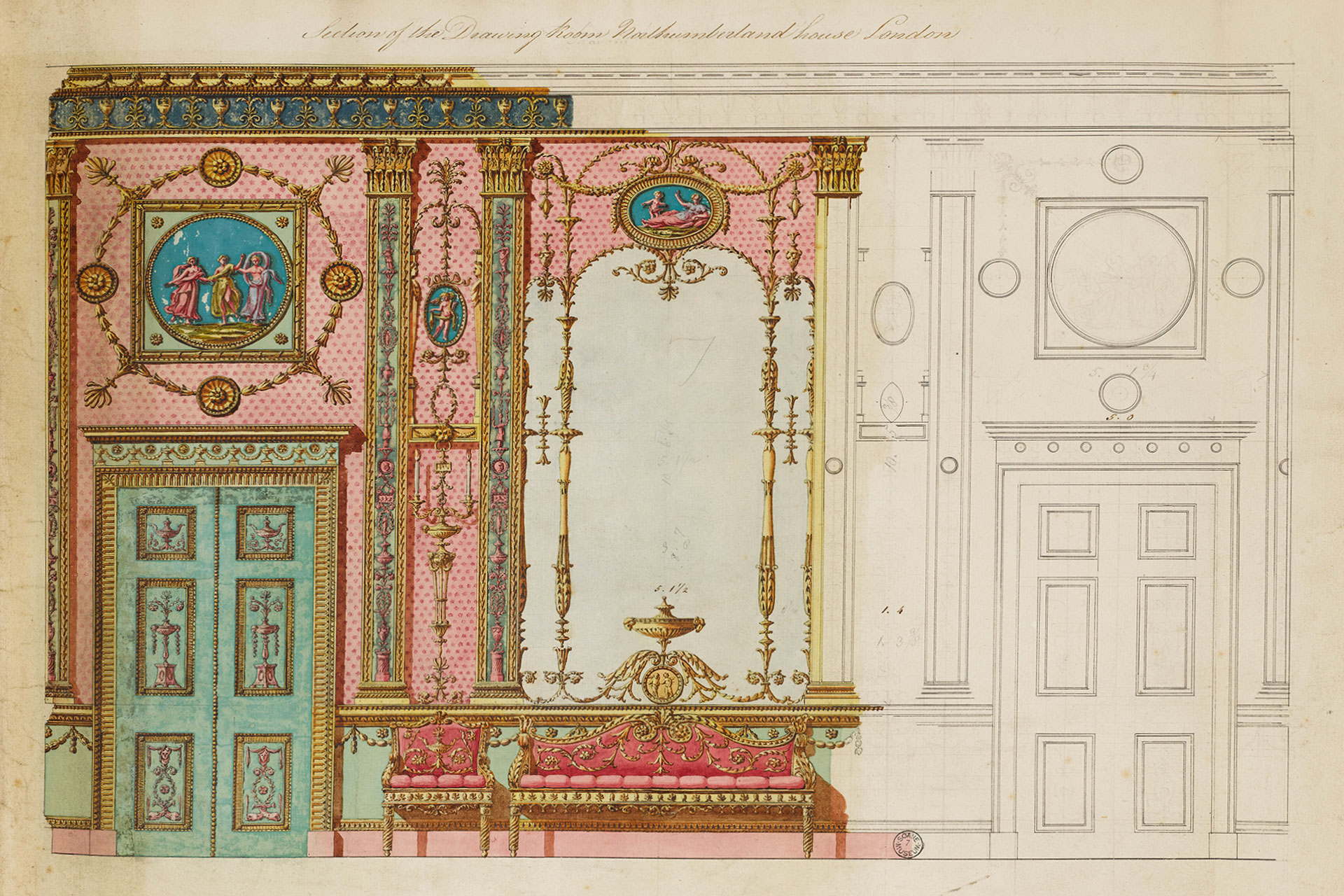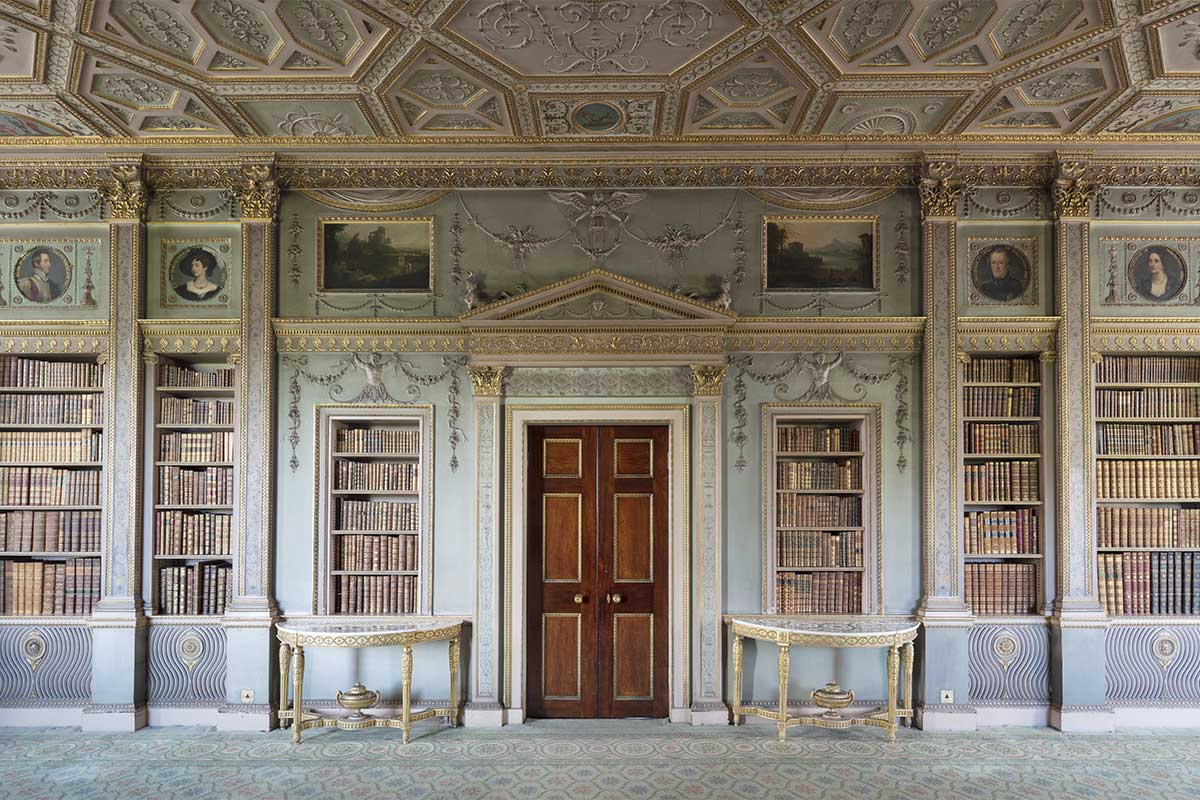A book by Adriano Aymonino – Mirroring power and self-representation through design. The patronage and collecting practices of the 1st Duke and Duchess of Northumberland become a taste artifact
Introducing a newly launched catalog of taste and design
From art history and design techniques to socio-economical radiography of eighteenth-century Britain. Enlightened Eclecticism attempts to offer its reader a holistic experience. Adriano Aymonino is the composer of a thorough and harmonic analysis of the Northumberland’s 1st Duke and Duchess. Collecting and refurbishing patterns. He portrays the couple through their intertwined character. Decorating behaviors or instincts whilst utterly attesting to a private and public taste development. Sir Hugh Smithson (1712–86) and Lady Elizabeth Seymour Percy (1716–76) become patrons of eclecticism. They weave Palladianism, rococo, neoclassicism, and Gothic revival styles into new space aesthetics that remain influential today.
Enlightened Eclecticism: The Grand Design of the 1st Duke and Duchess of Northumberland
The writer captures the couple’s versatile ornamentation sensibility through specific chapters. These ones are dedicated to each of their four houses: Stanwick Hall, Northumberland House, Syon House, and Alnwick Castle. In addition, funerary monuments and collected objects can further attest to their influence over architecture and the Georgian London public sphere.
A careful examination of both interiors and facades reflects «a radical shift from a society of the ancien régime; to the first glimpses of a more modern, commercial, and industrial age». As the author explains, the frame of these discoveries is pregnant with commercial and economic shifts. Eventually they culminate in a consumption-driven economy. In order to guide the reader towards an integrative understanding. Aymonino accompanies his study with illustrations, paintings, and drawings alongside a map of properties and the family tree.
The aesthetics of cultural elevation and feminist engagement
Sir Hugh Smithson and Lady Elizabeth Seymour Percy are the book’s protagonists. Together with the architect Robert Adam and his work that intrinsically connects with their patronage. The conflict emerging from the juxtaposition of styles is responsible for the visual tension. Furthermore, these are between «national and international; ancient and modern, conservative and innovative, commercial and academic». In the eyes of the author, it «generated a fertile aesthetic debate. Often coexisting within the same patron and collector».
This opposition transforms into a dialogue, more specifically into a conversation giving birth to innovative artistic endeavors. Two ‘legislators of taste’, Sir Smithson and Princess Elizabeth; identify through the relationship they create with the environment and decor objects. Sir Hugh’s taste was «shaped by the culture of classicism. The so-called ‘Rule of Taste,’ focused on the antiquities of Greece and Rome. Hers was instead dictated by a cultivation of the notion of the sublime; and the picturesque, and by a passion for the Gothic; the Middle Ages, the history of Britain, and the north of Europe» the author observes.
The age of the bluestocking – Enlightened Eclecticism
Domestic sociability, self-promotion, civic engagement; and the feminization of public life are themes the book surveys in iconographic language and the written word. While his research focuses on the architecture aesthetic in a time of expansion and increasing travel facilitation. Aymonino also underlines the feminine emancipation phenomenon reflected in the design tendencies of Lady Elizabeth. The author notes that «the age of the bluestocking is also the age of great female builders and collectors. An age in which aristocratic women enjoyed a social and financial freedom not experienced before».
With each fragment of their work, the couple testifies; equality and balance is responsible for the allure and complexity of their patronage in high society. Northumberland’s 1st Duke and Duchess become a model of deliberate instigation of new styles. In an epoch when the rigid architectural and artistic royal or church favoritism was absent. Therefore, «the role of private patrons was of primary importance. In the style and tendencies affirmation in these fields», portrays the writer. «Indeed, the Northumberland’s’ wealth of activities reaffirm the role played by grand families in promoting new directions in architecture; interior decoration, and display in the central decades of the century. To conclude, in the absence of proactive court or church patronage on a large scale».
Environment cosmeticization
Within their collecting practices and the process of meaning-making through environment cosmeticization. Sir Hugh Smithson and Lady Elizabeth Seymour Percy redeem the political status of their houses, assigning them purpose and roles. One example is the Syon House. «re-imagined as a new Roman villa at the vanguard of the national taste, fit for a new ‘Roman senator’». While the Alnwick Castle, «the ‘Old Northern Castle,’ was intended to tower metaphorically; and physically over the ‘mock Gothic’ diffused in the 1750s. A grand restoration of a real medieval castle to outshine the ‘little Gothic castles’ of Horace Walpole; and his friends or those of Lady Pomfret and Lady Oxford». Between heraldic displays, classical and Gothic details. Or the illustrated books, each element has the role to evoke the context of ‘the great design’; and inspire future collecting studies.
Will Enlightened Eclecticism acquire shelves residency?
In its 400 pages, the book itself is a collector item. Dedicated to whoever approaches with interest the elongation and customization of taste. Adriano Aymonino emphasizes his art historian viewpoint. With an approach that «is more concerned with the cultural and aesthetic spheres. Focusing on the physical buildings and artworks and considering these holistically to evoke their now absent features». The book envelops the aesthetic and architectural seek in a «history of collecting and patronage» revisitation. Seen «as a field of study that sits precariously; between the history of art, history, and the social and economic sciences».
More than that, the book captures the idea of community empowerment. When confessing to the acts of an artist’s promotion and education directed by the Duke and Duchess. With the establishment of new cultural codes and visual vocabularies; the couple remains loyal to its heritage and bloodline, ruling a taste-fueled brand. Each item is then chosen as part of a whole. The book analyzes them individually and collectively.
However, Adriano Ayymano’s goal is to showcase the aesthetic style of an era. «this book, although focused on architecture, design, and collecting, is primarily interested in taste. Therefore on how broader cultural adherences are reflected in buildings, interiors, and display».
Dedication to ancestral objects
The book doesn’t fail to present the reader with the remains of the houses, demolished and forgotten. Consequently, the demolition of the houses becomes the witness to the ephemerality of some of the presented artifacts. Lacking synonymous researches, the book’s depth is characterized by three main dimensions. The author explores in detail. «First, there was the world of the town; which promoted a metropolitan, consumerist, and plural approach to culture» followed by «the second cultural framework. That was the world of the old aristocracy». Finally, «there was the cultural world of the ‘Republic of Letters’, of antiquarianism, classical taste, and scholarship». Overall, Enlightened Eclecticism provides the reader with the tools. To understand and appreciate the architectural manifestations of Georgian London. Collecting all the taste evidence of that epoch.
Adriano Aymonino
Adriano Aymonino is the director of the University of Buckingham’s undergraduate History and History of Art Programme. He received a BA in History of Art from the Sapienza Università di Roma. An MA in Cultural and Intellectual History 1300-1650 from the Warburg Institute. A Ph.D. in Theories and History of Art from the IUAV and the Università di Venezia Ca’ Foscari.
He has held various grants and fellowships. Including ones awarded by the Paul Mellon Centre for Studies; in British Art (Yale University). the Getty Research Institute in Los Angeles; and the Huntington Library in Pasadena. Prior to joining the University in 2012; he worked as head of research for the Commission for Looted Art in Europe, based in London.




















